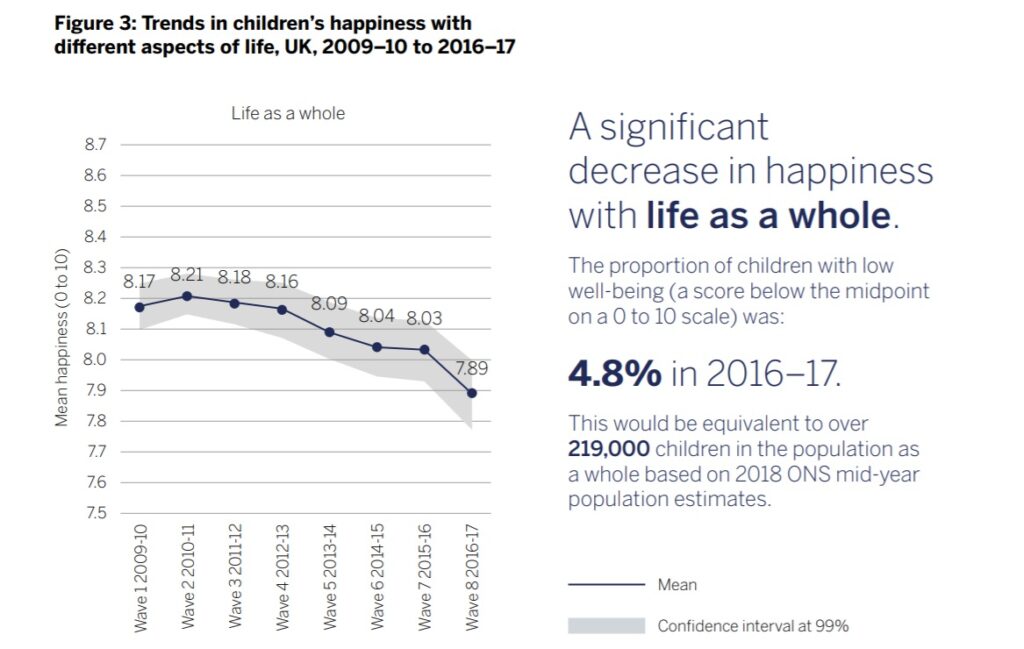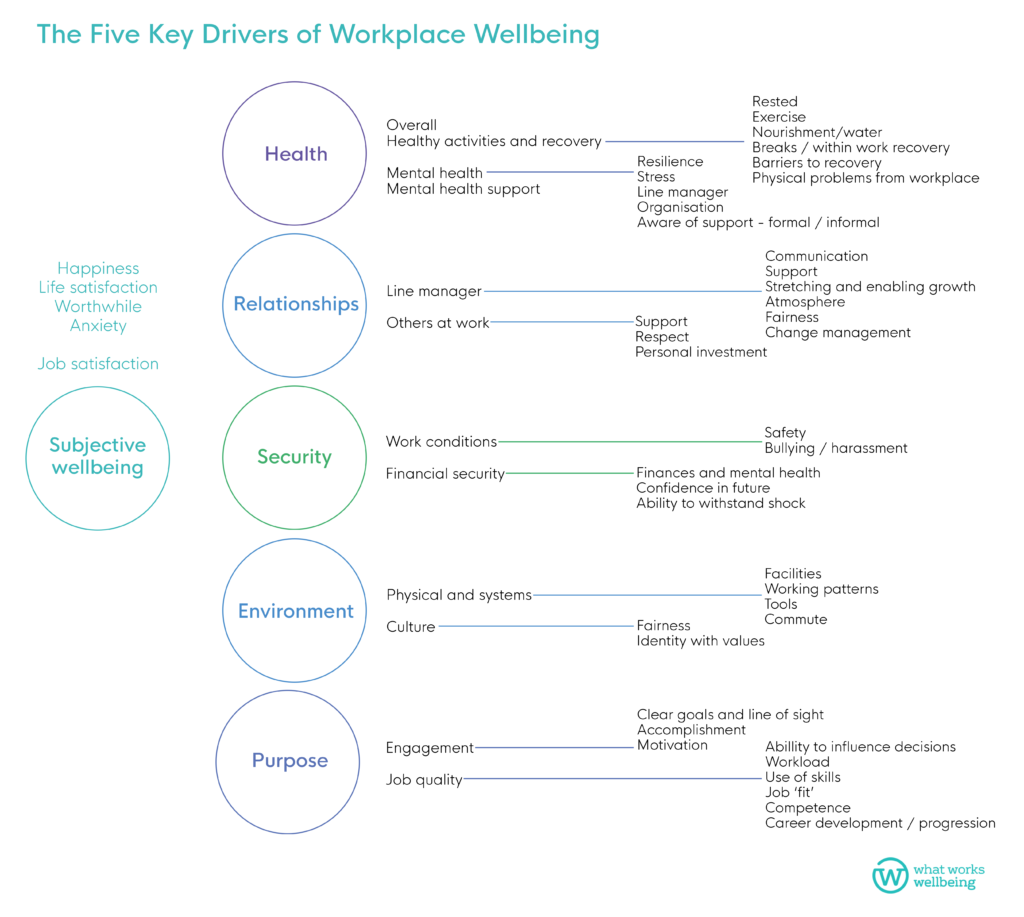A note from the Centre:
There are a wide range of high quality wellbeing measurement products and services for staff and student wellbeing available. Do check that the product you use or develop includes robust questions covering the key core measures accurately, that it covers all the domains of wellbeing and that you know how best to interpret and use the results.
Since publishing this blog, we have developed specific guidance for schools and colleges in England to take action to protect and promote the health and wellbeing of staff in education settings. The guide will also support schools and colleges to implement the Education Staff Wellbeing Charter.
The evidence from NHS Digital, Good Childhood report and other sources shows that:
- children’s mental health has been declining over the last decade or so
- children appear to be significantly less happy with their lives.
More recently, there has been a lot of speculation about the state of children’s mental health as a result of the coronavirus pandemic with some articles claiming a ‘generation of children could be scarred’. Additionally, education professionals are experiencing poor mental health as a direct result of their jobs, at levels much higher than the national average.

Source: The Good Childhood Report (2019)
Why is it that, in a country that is so wealthy and was, until recently, relatively safe to live in, do our children seem to be increasingly unhappy? In what ways is the global pandemic affecting children’s mental health? Why are so many teachers and school leaders stressed and anxious at work? To answer these questions, and in the search for solutions, schools are starting to measure wellbeing. But, at present, that’s not as straightforward as it sounds.
More measurement in schools? Why wellbeing?
Some critics would argue that yet more data gathering for schools is a recipe for disaster – schools are already drowning in assessments of various kinds. However, there are strong grounds for measuring pupil wellbeing because of its links with positive educational outcomes.
The government report, The link between student health wellbeing and attainment, shows that when schools actively put in place whole school programmes to develop student’s social and emotional skills, there were significant gains in attainment. It appears to be true that, generally speaking, happier children learn better. Recently, Schools Minister, Nick Gibb, also recommended that schools measure staff wellbeing at regular intervals and publish the results, as part of a ‘wellbeing charter’ to improve staff wellbeing.
- Schools that measure wellbeing know their starting point, and the unique issues facing their pupils and staff. This is particularly true when children return to school after a prolonged period away as a result of the lockdown. Only then can interventions and whole school policies be designed, chosen and tailored to suit their needs.
- Once wellbeing programmes and interventions are in place, schools then need to measure and monitor their impact and effectiveness over time. Measuring wellbeing can also help schools identify children and young people that might need specialist intervention – otherwise, they risk falling through the gaps.
- If all schools routinely measured their pupils’ and employees’ wellbeing, it may be possible to compare data and see what it is that some schools do to successfully improve outcomes for their school communities.
Which wellbeing measure to use?
The next quandary for schools to face is deciding what measure of wellbeing to use. There are just so many and they all measure slightly different things. Helpfully, organisations like the Anna Freud Centre have designed a toolkit for measuring children’s wellbeing.
Even so, this toolkit lists 30 different measures of pupil wellbeing and schools face a paradox of choice. To narrow down the choice, schools must carefully consider what it is, exactly, they are hoping to measure.
Are they hoping to take a snapshot of overall pupil wellbeing in the school to track over time? Or are they wanting to measure the impact of interventions used with a select group of children? Thankfully, the Child Outcomes Research Consortium (CORC) have created a free e-learning module called ‘measuring mental wellbeing to improve the lives of children and young people’ to help schools answer these and many other questions.
Staff wellbeing has a longer track-record of being measured, especially by likes of teaching unions and charities like Education Support. Anna Freud and Education Support offer good staff wellbeing measurement services but these are not free and cash-strapped schools may want to be able to do this in-house.
Measuring wellbeing
Once a wellbeing measure has been selected, the next step is to get pupils and staff to fill in the survey.
The e-learning module by CORC gives very good guidance in this area. It’s important to communicate to the people taking the survey why they are being asked to fill it in and what you will be doing with the data.

Source: The Good Childhood Report (2019)
In the school I work in, we told our pupils (and their parents and carers via a letter home) that we wanted to see how they felt about their lives inside and outside of school and what we could do to make their lives better. We informed staff it was the survey was to see how staff felt about working at the school and what could be done to improve their working lives. The five main drivers of wellbeing in the workplace, identified by the Centre, are set out below.

We ran anonymous surveys and we used the questions in the Good Childhood Index for pupils (short version) and the What Works Centre for Wellbeing Employee Snapshot Survey. We also informed pupils that if answering the survey brought up any difficult feelings, there was a member of staff available to speak with them.
My school used an excellent online tool called Bounce Together to administer the surveys, provide real-time results and to help us analyse the data. The plan is to carry this surveys out at the beginning and end of each academic year, to see if any trends emerge, to identify what we can do as a school to support our staff, children and their families, and to gauge the impact our wellbeing-related work is having on our school community.
What next for measuring wellbeing?
There’s no doubt that measuring wellbeing has become much easier with the help and support of organisations like Bounce Together, CORC and Anna Freud. But it still feels like a bit of a minefield for many schools who simply don’t know where to begin. And for the schools that are already measuring pupil and staff wellbeing, if they are all using different wellbeing measures, in different ways, at different times of years, using different tools, can we make any reliable comparisons between them?
I feel there is a real need for an agreed robust measure of wellbeing that could be administered in all schools across the UK. A national emotional health-check of our children and teaching staff taken annually in schools. We would then have a much better idea of what school-factors affect their mental health and wellbeing and how schools may be able to support their communities better. That way we could stop the speculation and actually know how our children and teachers are fairing.
